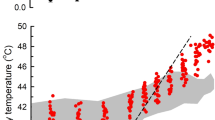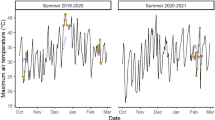Summary
Most of the monarch butterflies kept at 4–5° C for a few days shivered when released at a test temperature of 15–16° C, whereas fewer of the butterflies kept at 23–24° C did so. Cold-acclimated butterflies shivered more readily, as indicated by the length of the interval between release at the test temperature and the onset of shivering, and they shivered for longer periods of time. The effects of cold acclimation were reversible, but in only 1 out of 3 replicates was the warm acclimation clearly reversed. Cool animals shivered at room temperature, indicating that body temperature and not ambient temperature is important in releasing the behavior. It is suggested that the acclimation involves alteration in the central neurons controlling the activity of muscles involved in shivering.
Similar content being viewed by others
References
Davidson, T. F.: Changes in the temperature tolerance during the life cycle of Calliphora erythrocephala. J. Insect Physiol. 15, 977–988 (1969).
Dierolf, B. M., McDonald, H. S.: Effects of temperature acclimation on electrical properties of earthworm giant axons. Z. vergl. Physiol. 62, 284–290 (1969).
Hanegan, J. L., Heath, J. E.: Temperature dependence of the neural control of the moth flight system. J. exp. Biol. 53, 629–639 (1970).
Kammer, A. E.: Motor patterns during flight and warm-up in Lepidoptera. J. exp. Biol. 48, 89–109 (1968).
—: Thoracic temperature, shivering, and flight in the monarch butterfly, Danaus plexippus (L.). Z. vergl. Physiol. 68, 334–344 (1970).
Kerkut, G. A., Taylor, B. J. R.: The effect of temperature changes on the activity of poikilotherms. Behaviour 13, 259–279 (1958).
Konishi, J., Hickman, C. P., Jr.: Temperature acclimation in the central nervous system of rainbow trout (Salmo gairdnerii). Comp. Biochem. Physiol. 13, 433–442 (1964).
Lagerspetz, K. Y. H., Talo, A.: Temperature acclimation of the functional parameters of the giant nerve fibres in Lumbricus terrestris L. I. Conduction velocity and the duration of the rising and falling phase of the action potential. J. exp. Biol. 47, 471–480 (1967).
Moran, V. C., Ewer, D. C.: Observations on certain characteristics of the flight motor of sphingid and saturniid moths. J. Insect Physiol. 12, 457–463 (1966).
Prosser, C. L., Fahri, E.: Effects of temperature on conditioned reflexes and on nerve conduction in fish. Z. vergl. Physiol. 50, 91–101 (1965).
United States Weather Bureau: Climatography of the United States, No. 11-4. Climatic summary of the United States-Supplement for 1931 through 1952.
- Climatological Data, California. 71 (1967), 72 (1968), 73 (1969).
Urquhart, F. A.: The monarch butterfly. Toronto: Univ. Toronto Press 1960.
Wigglesworth, V. B.: The principles of insect physiology. London: Methuen 1965.
Author information
Authors and Affiliations
Additional information
I thank Miss Janice Ruppert and Mr. C. J. Doughty for their valuable technical assistance. The co-operation of the administrators of New Brighton Beach State Park in permitting me to collect in the park is appreciated.
Rights and permissions
About this article
Cite this article
Kammer, A.E. Influence of acclimation temperature on the shivering behavior of the butterfly Danaus plexippus (L.). Z. vergl. Physiologie 72, 364–369 (1971). https://doi.org/10.1007/BF00300709
Received:
Issue Date:
DOI: https://doi.org/10.1007/BF00300709




